Novel Pour Point Depressants for Crude Oil Derived from Polyethylene Solution in Hexane and Coal Fly Ash
Abstract
1. Introduction
2. Materials and Methods
2.1. Materials
2.2. Obtaining MSPs from Coal Fly Ash
2.3. Preparation of the Potential Pour Point Depressants (PPDs)
2.4. Evaluating Tests of Pour Point
2.5. Rheological Measurements
2.6. Viscosity Curve Test
2.7. Elemental Analysis
2.8. Determination of Particle Size
2.9. Photomicrographic Analysis
2.10. Differential Scanning Calorimetry
3. Results and Discussion
3.1. Characterization of Crude Oil Sample
3.2. Characterization of Coal Fly Ash MNPs
3.3. Evaluation of Prepared Pour Point Depressants
3.4. Viscosity Curve Test
3.5. Differential Scanning Calorimetry
3.6. Microscopic Observations
3.7. Mechanism of Action: Polyethylene/MNPs as PPDs for Crude Oil
4. Conclusions
Author Contributions
Funding
Data Availability Statement
Conflicts of Interest
References
- Steckel, L.; Nunes, R.C.; Rocha, P.C.; Ramos, A.C.; Alvares, D.R.; Lucas, E.F. Pour point depressant: Identification of critical wax content and model system to estimate performance in crude oil. Fuel 2022, 307, 121853. [Google Scholar] [CrossRef]
- Adams, J.J.; Tort, F.; Loveridge, J.; Bolton, N.; Forney, J. Physicochemical Approach to Pour Point Depressant Treatment of Waxy Crudes. Energy Fuels 2023, 37, 6432–6449. [Google Scholar] [CrossRef]
- Yao, B.; Li, C.; Yang, F.; Sun, G.; Xia, X.; Ashmawy, A.M.; Zeng, H. Advances in and perspectives on strategies for improving the flowability of waxy oils. Energy Fuels 2022, 36, 7987–8025. [Google Scholar] [CrossRef]
- Sharma, S.; Mahto, V.; Sharma, V.P. Effect of flow improvers on rheological and microscopic properties of indian waxy crude oil. Ind. Eng. Chem. Res. 2014, 53, 4525–4533. [Google Scholar] [CrossRef]
- Zhang, X.; Li, N.; Wei, Z.; Han, S.; Dai, B.; Lin, H. Synthesis of nano-hybrid polymethacrylate-carbon dots as pour point depressant and combined with ethylene-vinyl acetate resin to improve the cold flow properties of diesel fuels. Energy 2022, 253, 124186. [Google Scholar] [CrossRef]
- Elkatory, M.R.; Hassaan, M.A.; Soliman, E.A.; Niculescu, V.-C.; Raboaca, M.S.; El Nemr, A. Influence of poly (benzyl oleate-co-maleic anhydride) pour point depressant with di-stearyl amine on waxy crude oil. Polymers 2023, 15, 306. [Google Scholar] [CrossRef]
- Yuan, D.; Liu, Q.; Zhang, W.; Liu, R.; Jiang, C.; Chen, H.; Yan, J.; Gu, Y.; Yang, B. Synthesis and Performance Testing of Maleic Anhydride–Ene Monomers Multicomponent Co-Polymers as Pour Point Depressant for Crude Oil. Polymers 2023, 15, 3898. [Google Scholar] [CrossRef]
- Nikolaev, A.; Plotnikova, K. Study of the Rheological Properties and Flow Process of High-Viscosity Oil Using De-pressant Additives. Energies 2023, 16, 6296. [Google Scholar] [CrossRef]
- Chen, J.; Cui, L.; Xu, B.; Lin, H.; Han, S. Influence of polymers with surfactant properties as pour point depressants on the cold flow properties of diesel fuel. Colloids Surf. A Physicochem. Eng. Asp. 2023, 677, 132390. [Google Scholar] [CrossRef]
- Sun, B.; Su, B.; Zhao, Y.; Xu, B.; Xue, Y.; Lin, H.; Han, S. Synthesis of methacrylate–vinyl acetate–N-phenylmethylpropionamide terpolymers as pour point depressants and combined with methyl palmitoleate to improve the cold flowability of waste cooking oil biodiesel blends. J. Mol. Liq. 2022, 368, 120796. [Google Scholar] [CrossRef]
- Marenov, B.T.; Nadirov, K.S.; Zhantasov, M.K.; Nadirov, R.K. Ethylene-vinyl acetate copolymer/crude gossypol compositions as pour point depressants for waxy oil. Int. J. Chem. Eng. 2020, 2020, 4195382. [Google Scholar] [CrossRef]
- Nadirov, K.S.; Zhantasov, M.K.; Marenov, B.T.; Bimbetova, G.Z.; Orynbasarov, A.K.; Shukhanova, Z.K.; Otarbayev, N.S.; Nadirova, Z.K.; Iztleuov, G.M.; Zhantasova, D.M. Obtaining High-Paraffin-Content Oil Depressants. Chem. Eng. Technol. 2021, 44, 310–317. [Google Scholar] [CrossRef]
- Huang, H.-R.; Wang, W.; Peng, Z.-H.; Li, K.; Ding, Y.-F.; Yu, W.-J.; Gan, D.-Y.; Wang, C.-S.; Xue, Y.-H.; Gong, J. Synergistic effect of magnetic field and nanocomposite pour point depressant on the yield stress of waxy model oil. Pet. Sci. 2020, 17, 838–848. [Google Scholar] [CrossRef]
- Mao, J.; Kang, Z.; Yang, X.; Lin, C.; Zheng, L.; Zuo, M.; Mao, J.; Dai, S.; Xue, J.; Ouyang, D. Synthesis and performance evaluation of a nanocomposite pour-point depressant and viscosity reducer for high-pour-point heavy oil. Energy Fuels 2020, 34, 7965–7973. [Google Scholar] [CrossRef]
- Wang, C.; Liu, Y.; Hu, S.; Lv, X.; Zhao, B.; Ma, Q.; Zhou, S. Experimental study of the effects of a magnetic field/magnetic field-ferromagnetic nanocomposite pour point depressant on wax deposition. RSC Adv. 2024, 14, 6234–6245. [Google Scholar] [CrossRef]
- Huang, H.; Li, K.; Wang, D.; Liang, P.; Yang, J.; Ding, Y.; Gong, J. Further discussion of nanocomposite pour point depressants on the influence of paraffin wax crystallization: A novel small angle x-ray diffraction study. Cryst. Growth Des. 2022, 22, 6870–6878. [Google Scholar] [CrossRef]
- Gao, S.; Yang, Y.; Falchevskaya, A.S.; Vinogradov, V.V.; Yuan, B.; Liu, J.; Sun, X. Phase Transition Liquid Metal Enabled Emerging Biomedical Technologies and Applications. Adv. Sci. 2023, 2306692. [Google Scholar] [CrossRef]
- Zhong, X.; Chen, J.; An, R.; Li, K.; Chen, M. A state-of-the-art review of nanoparticle applications with a focus on heavy oil viscosity reduction. J. Mol. Liq. 2021, 344, 117845. [Google Scholar] [CrossRef]
- Sharma, R.; Deka, B.; Mahto, V.; Vuthaluru, H.; Li, C.-Z. Investigation into the flow assurance of waxy crude oil by application of graphene-based novel nanocomposite pour point depressants. Energy Fuels 2019, 33, 12330–12345. [Google Scholar] [CrossRef]
- Yang, F.; Paso, K.; Norrman, J.; Li, C.; Oschmann, H.; Sjöblom, J. Hydrophilic nanoparticles facilitate wax inhibition. Energy Fuels 2015, 29, 1368–1374. [Google Scholar] [CrossRef]
- Sharma, R.; Mahto, V.; Vuthaluru, H. Synthesis of PMMA/modified graphene oxide nanocomposite pour point de-pressant and its effect on the flow properties of Indian waxy crude oil. Fuel 2019, 235, 1245–1259. [Google Scholar] [CrossRef]
- Ko, S.; Huh, C. Use of nanoparticles for oil production applications. J. Pet. Sci. Eng. 2018, 172, 97–114. [Google Scholar] [CrossRef]
- Yu, H.; Sun, Z.; Jing, G.; Zhen, Z.; Liu, Y.; Guo, K. Effect of a magnetic nanocomposite pour point depressant on the structural properties of Daqing waxy crude oil. Energy Fuels 2019, 33, 6069–6075. [Google Scholar] [CrossRef]
- He, X.; Zheng, S.; Huang, G.; Rong, Y. Solution grafting of maleic anhydride on low-density polyethylene: Effect on crystallization behavior. J. Macromol. Sci. Part B 2012, 52, 1265–1282. [Google Scholar] [CrossRef]
- Yang, F.; Zhao, Y.; Sjöblom, J.; Li, C.; Paso, K.G. Polymeric wax inhibitors and pour point depressants for waxy crude oils: A critical review. J. Dispers. Sci. Technol. 2014, 36, 213–225. [Google Scholar] [CrossRef]
- Kamal, R.S.; Shaban, M.M.; Raju, G.; Farag, R.K. High-density polyethylene waste (hdpe)-waste-modified lube oil nanocomposites as pour point depressants. ACS Omega 2021, 6, 31926–31934. [Google Scholar] [CrossRef]
- Okan, M.; Aydin, H.M.; Barsbay, M. Current approaches to waste polymer utilization and minimization: A review. J. Chem. Technol. Biotechnol. 2018, 94, 8–21. [Google Scholar] [CrossRef]
- Kawai, T.; Yasugi, T.; Mizunuma, K.; Horiguchi, S.; Ikeda, M. Comparative evaluation of blood and urine analysis as a tool for biological monitoring of n-hexane and toluene. Int. Arch. Occup. Environ. Health 1993, 65, S123–S126. [Google Scholar] [CrossRef]
- Yao, Z.; Xia, M.; Sarker, P.; Chen, T. A review of the alumina recovery from coal fly ash, with a focus in China. Fuel 2013, 120, 74–85. [Google Scholar] [CrossRef]
- Vassilev, S.V.; Menendez, R.; Borrego, A.G.; Diaz-Somoano, M.; Martinez-Tarazona, M.R. Phase-mineral and chemical composition of coal fly ashes as a basis for their multicomponent utilization. 3. Characterization of magnetic and char concentrates. Fuel 2004, 83, 1563–1583. [Google Scholar] [CrossRef]
- Yang, J.; Zhao, Y.; Zyryanov, V.; Zhang, J.; Zheng, C. Physical–chemical characteristics and elements enrichment of magnetospheres from coal fly ashes. Fuel 2014, 135, 15–26. [Google Scholar] [CrossRef]
- Dwivedi, S.; Saquib, Q.; Al-Khedhairy, A.A.; Ali, A.-Y.S.; Musarrat, J. Characterization of coal fly ash nanoparticles and induced oxidative DNA damage in human peripheral blood mononuclear cells. Sci. Total Environ. 2012, 437, 331–338. [Google Scholar] [CrossRef] [PubMed]
- Akinyemi, S.A.; Gitari, W.M.; Petrik, L.F.; Nyakuma, B.B.; Hower, J.C.; Ward, C.R.; Oliveira, M.L.; Silva, L.F. Environmental evaluation and nano-mineralogical study of fresh and unsaturated weathered coal fly ashes. Sci. Total Environ. 2019, 663, 177–188. [Google Scholar] [CrossRef] [PubMed]
- SY/T 7550-2004; Determination of Crude Oil in the Wax, Resin and Asphaltene Content. Chinese Standard: Singapore, 2004.
- ASTM Standard D-97; Standard Test Method for Pour Point of Petroleum Products. ASTM: West Conshohocken, PA, USA, 2022.
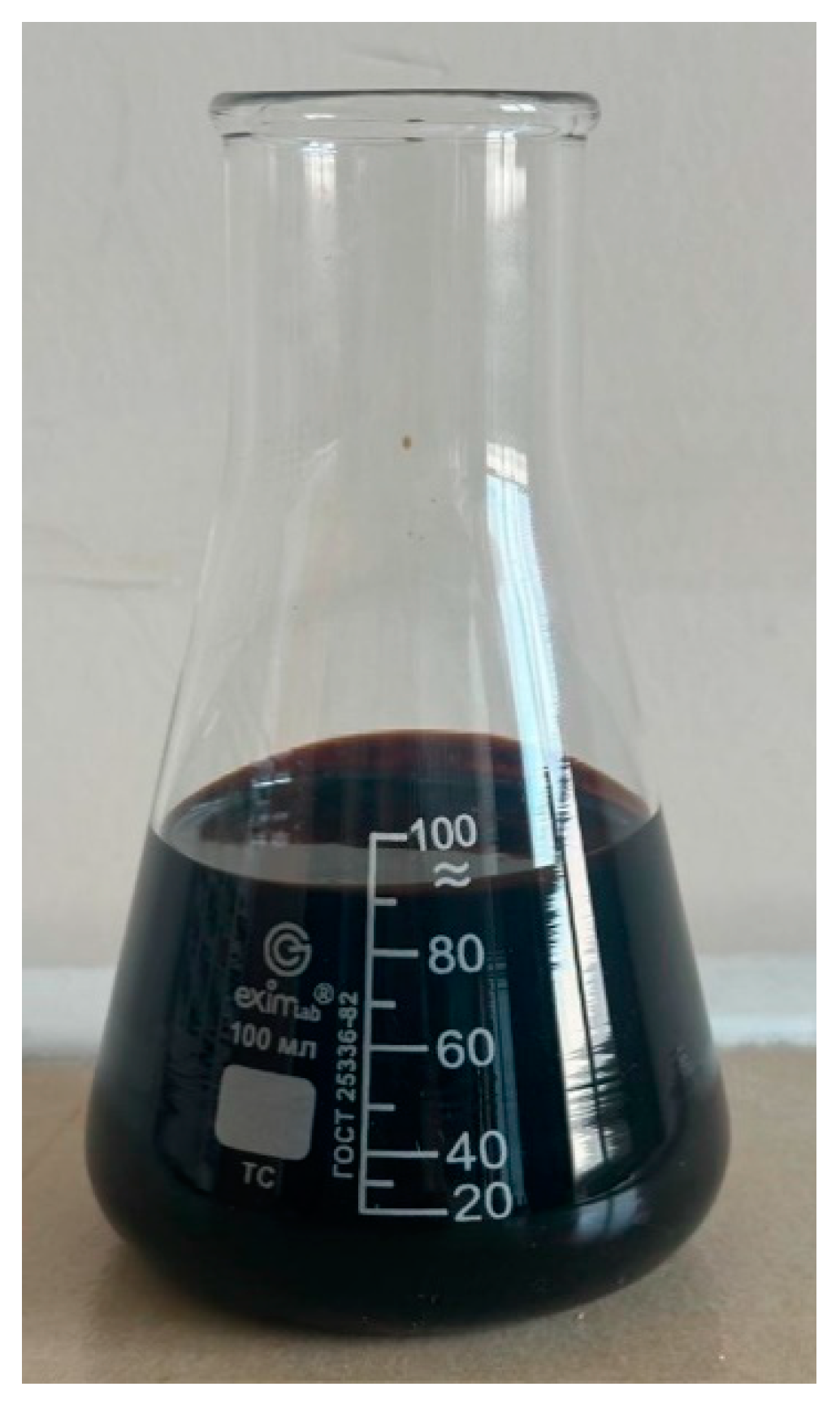
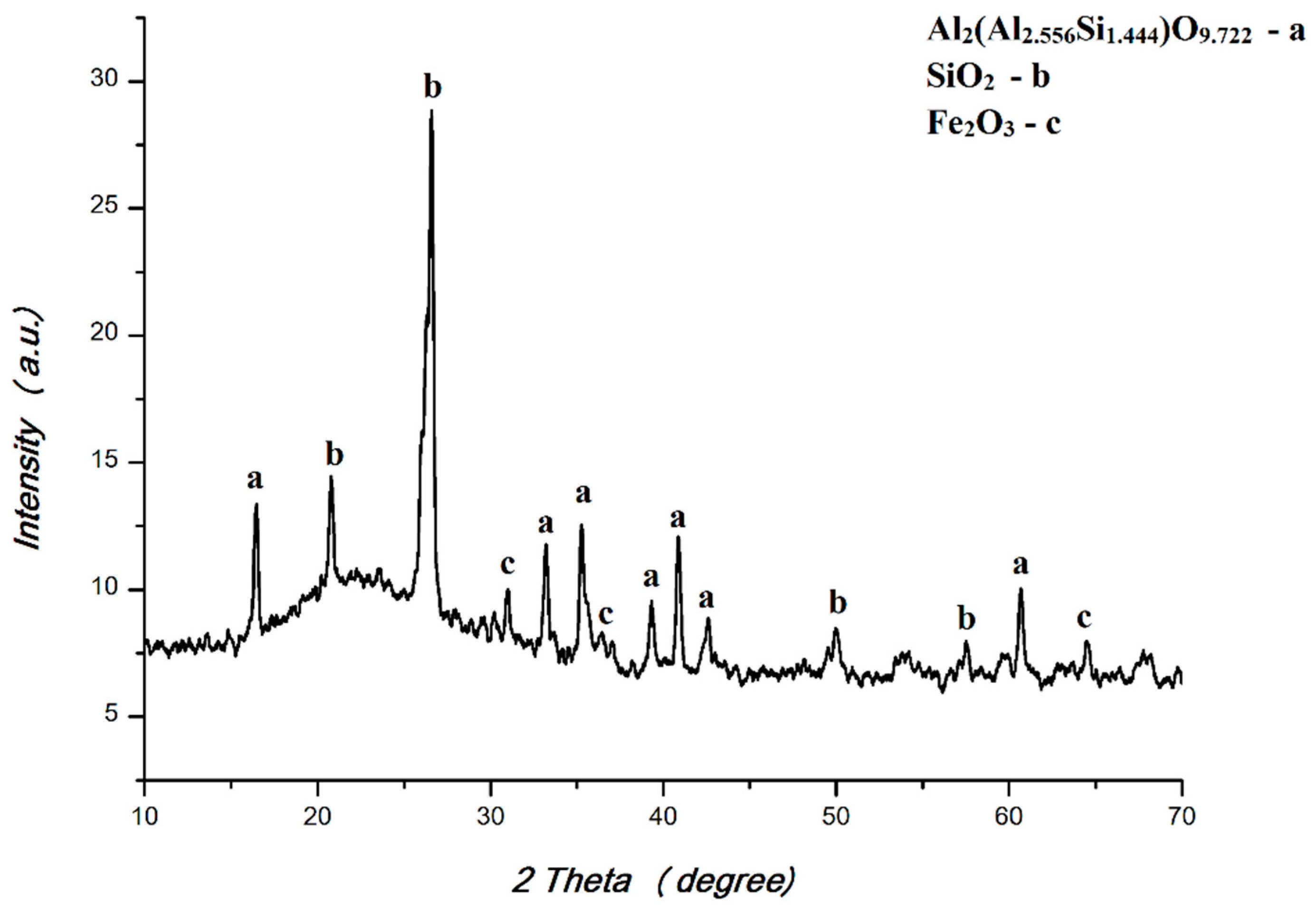
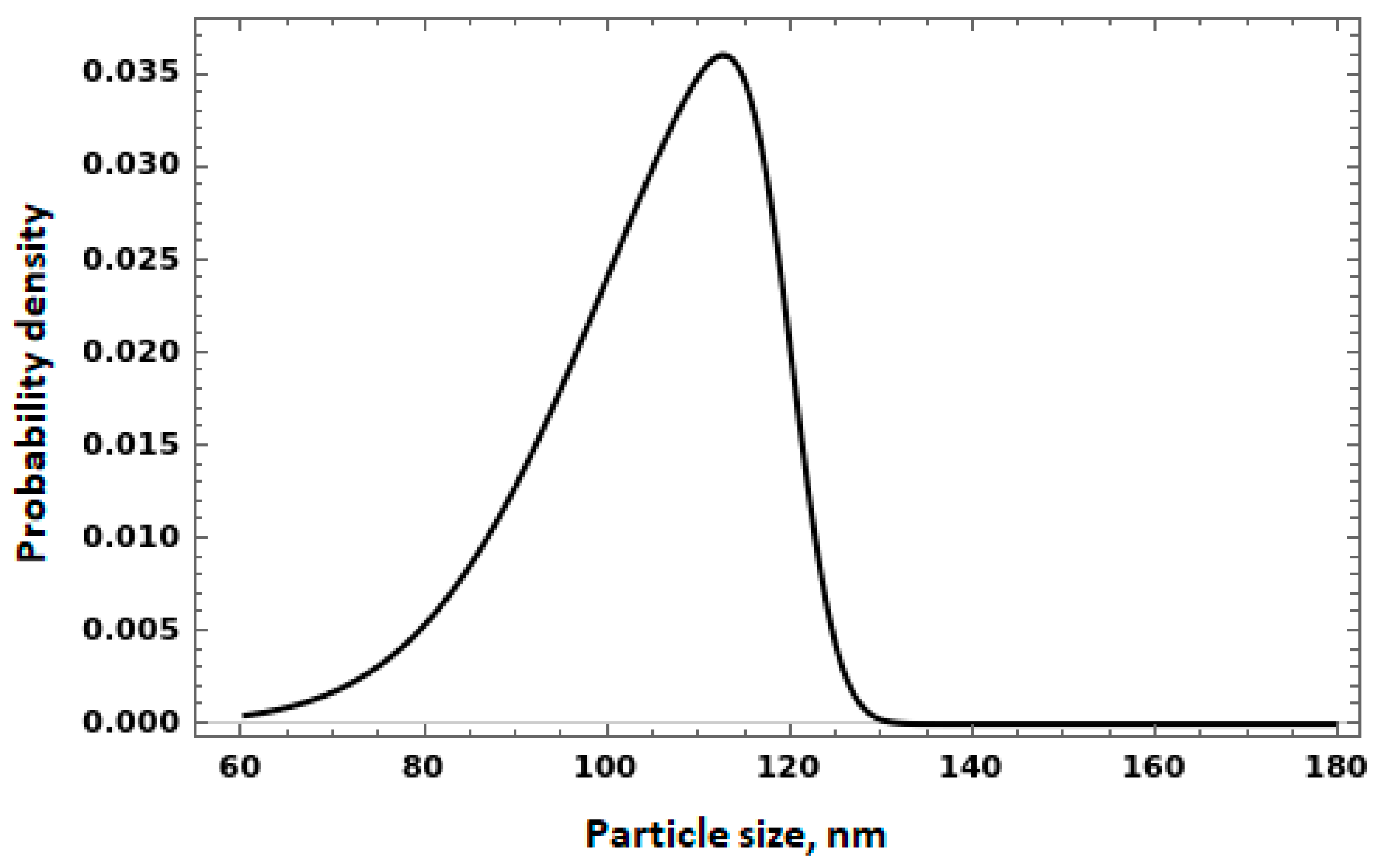

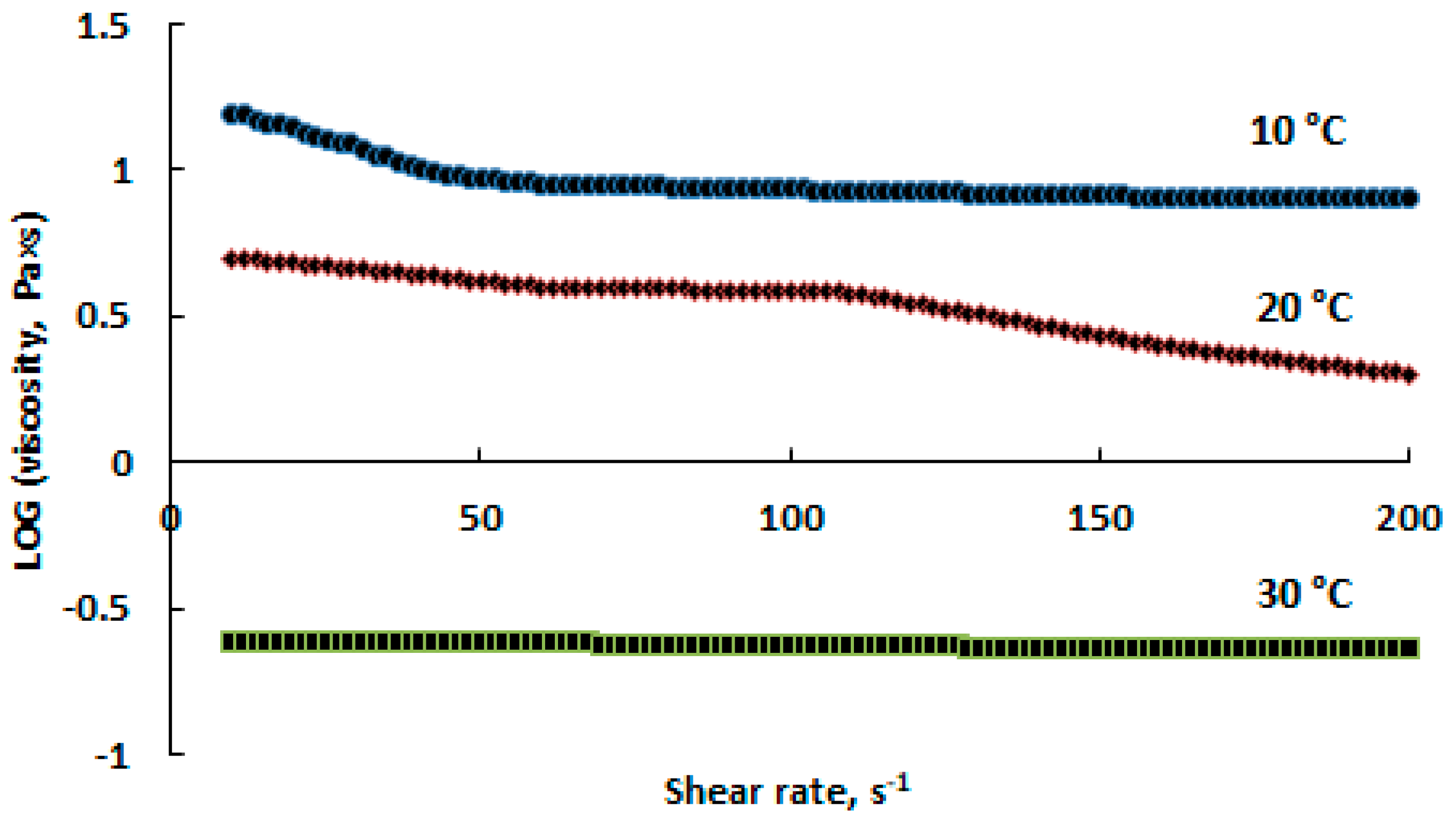
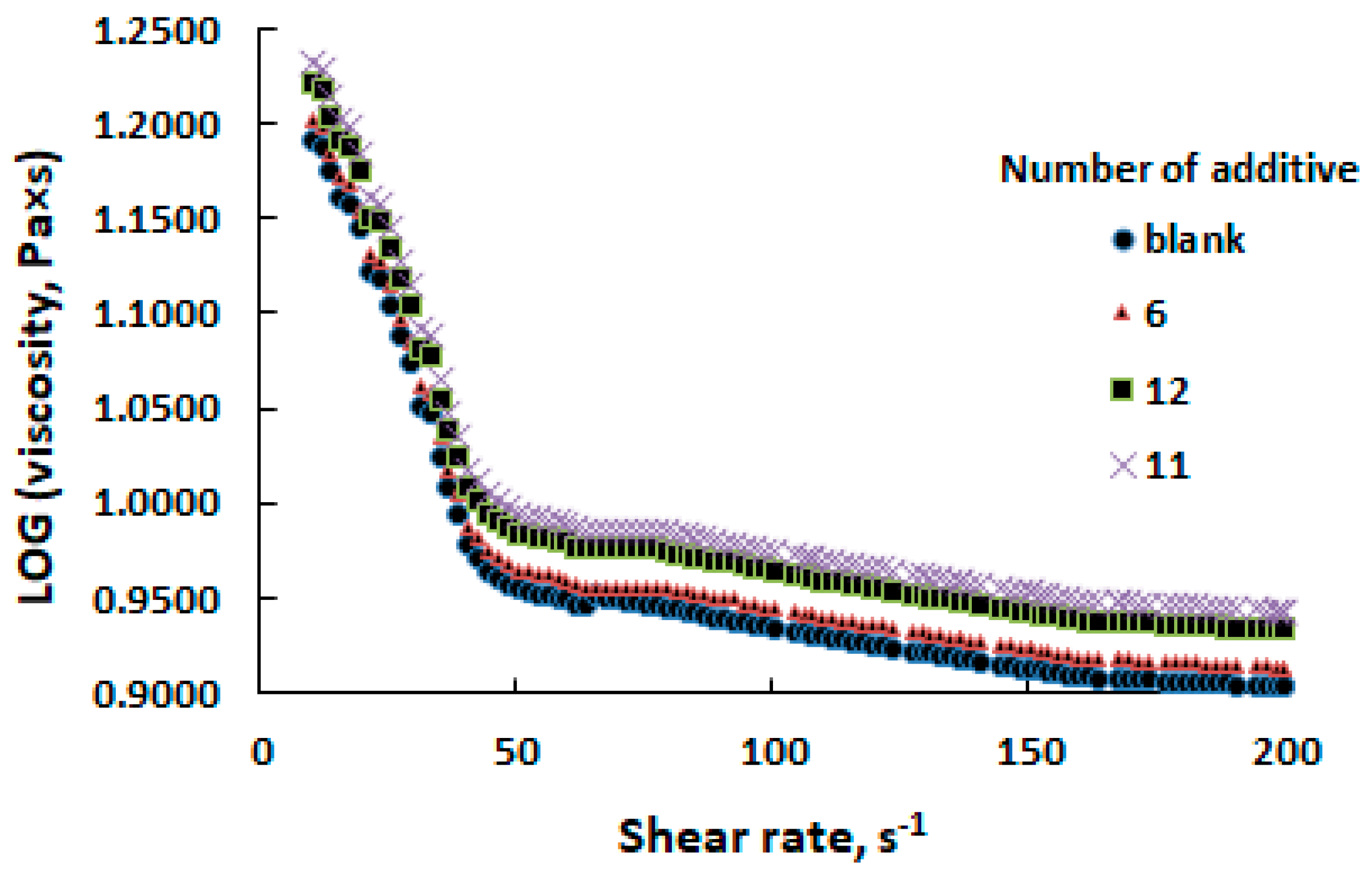
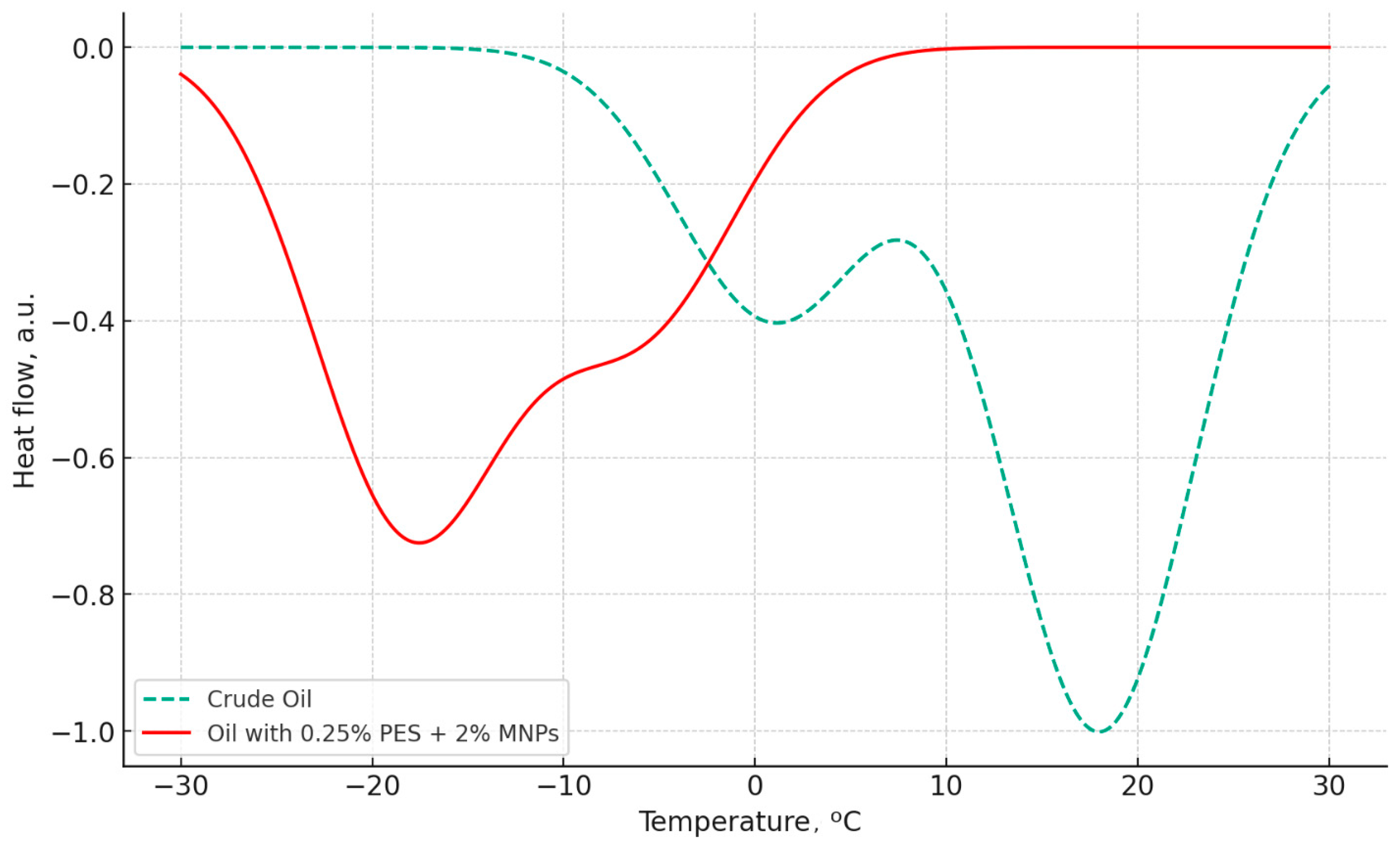
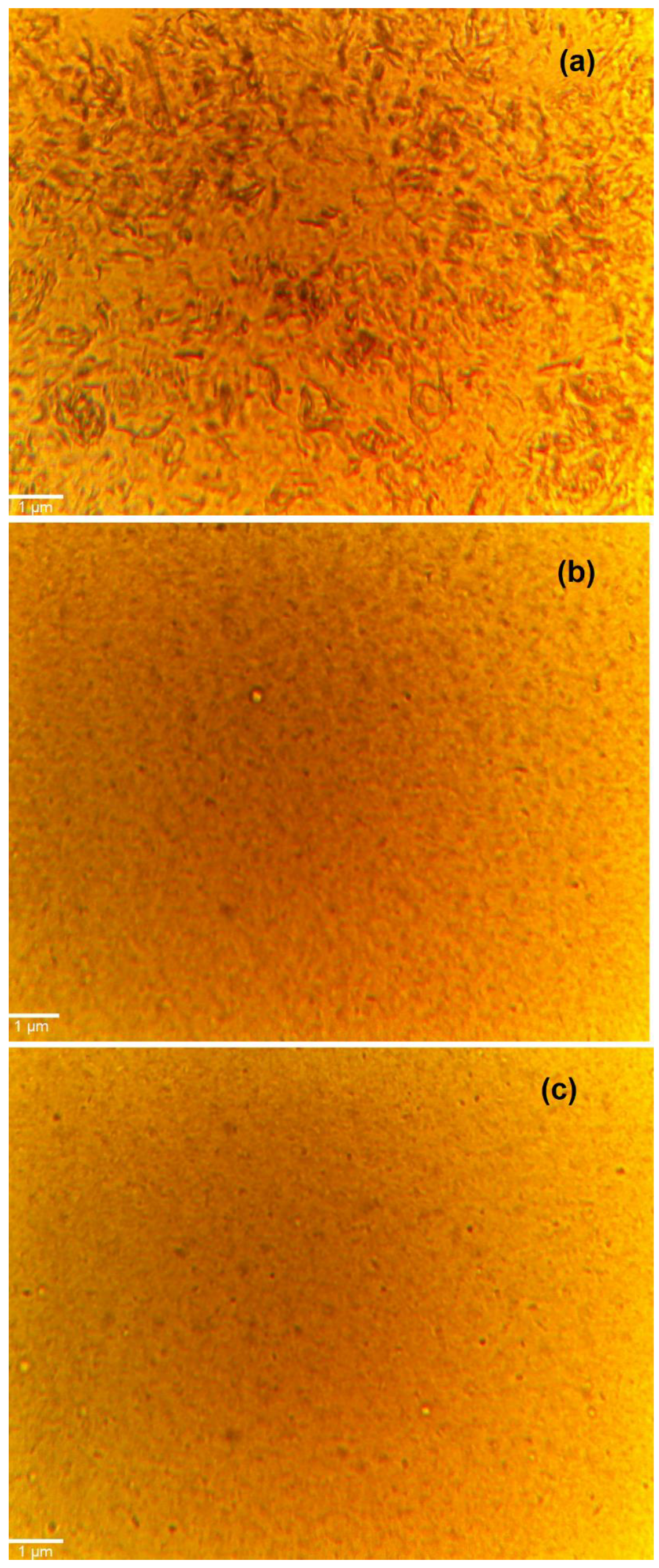
| Sample # | PPDs Composition |
|---|---|
| 1 | 0.25% PE in hexane (0.25% PES) |
| 2 | 0.5% PE in hexane (0.5% PES) |
| 3 | 1.0% PE in hexane (1.0% PES) |
| 4 | 1.5% PE in hexane (1.5% PES) |
| 5 | 2.0% PE in hexane (2.0% PES) |
| 6 | 0.25% PE in hexane (0.25% PES) + 1% MNPs |
| 7 | 0.5% PE in hexane (0.5% PES) + 1% MNPs |
| 8 | 1.0% PE in hexane (1.0% PES) + 1% MNPs |
| 9 | 1.5% PE in hexane (1.5% PES) + 1% MNPs |
| 10 | 2.0% PE in hexane (2.0% PES) + 1% MNPs |
| 11 | 0.25% PE in hexane (0.25% PES) + 2% MNPs |
| 12 | 0.5% PE in hexane (0.5% PES) + 2% MNPs |
| 13 | 1.0% PE in hexane (1.0% PES) + 2% MNPs |
| 14 | 1.5% PE in hexane (1.5% PES) + 2% MNPs |
| 15 | 2.0% PE in hexane (2.0% PES) + 2% MNPs |
| Characteristic | Value |
|---|---|
| density at 25 °C, g/cm3 | 0.8531 |
| dynamic viscosity at 25 °C, mPa × s | 185.9 |
| wax content, wt % | 19.1 |
| pour point, °C | 18 |
Disclaimer/Publisher’s Note: The statements, opinions and data contained in all publications are solely those of the individual author(s) and contributor(s) and not of MDPI and/or the editor(s). MDPI and/or the editor(s) disclaim responsibility for any injury to people or property resulting from any ideas, methods, instructions or products referred to in the content. |
© 2024 by the authors. Licensee MDPI, Basel, Switzerland. This article is an open access article distributed under the terms and conditions of the Creative Commons Attribution (CC BY) license (https://creativecommons.org/licenses/by/4.0/).
Share and Cite
Nadirov, K.; Zhantasov, M.; Ketegenov, T.; Nadirova, Z.; Batkal, A.; Kamunur, K.; Bimbetova, G.; Nadirov, R. Novel Pour Point Depressants for Crude Oil Derived from Polyethylene Solution in Hexane and Coal Fly Ash. Fluids 2024, 9, 121. https://doi.org/10.3390/fluids9060121
Nadirov K, Zhantasov M, Ketegenov T, Nadirova Z, Batkal A, Kamunur K, Bimbetova G, Nadirov R. Novel Pour Point Depressants for Crude Oil Derived from Polyethylene Solution in Hexane and Coal Fly Ash. Fluids. 2024; 9(6):121. https://doi.org/10.3390/fluids9060121
Chicago/Turabian StyleNadirov, Kazim, Manap Zhantasov, Tlek Ketegenov, Zhanna Nadirova, Aisulu Batkal, Kaster Kamunur, Gulmira Bimbetova, and Rashid Nadirov. 2024. "Novel Pour Point Depressants for Crude Oil Derived from Polyethylene Solution in Hexane and Coal Fly Ash" Fluids 9, no. 6: 121. https://doi.org/10.3390/fluids9060121
APA StyleNadirov, K., Zhantasov, M., Ketegenov, T., Nadirova, Z., Batkal, A., Kamunur, K., Bimbetova, G., & Nadirov, R. (2024). Novel Pour Point Depressants for Crude Oil Derived from Polyethylene Solution in Hexane and Coal Fly Ash. Fluids, 9(6), 121. https://doi.org/10.3390/fluids9060121






